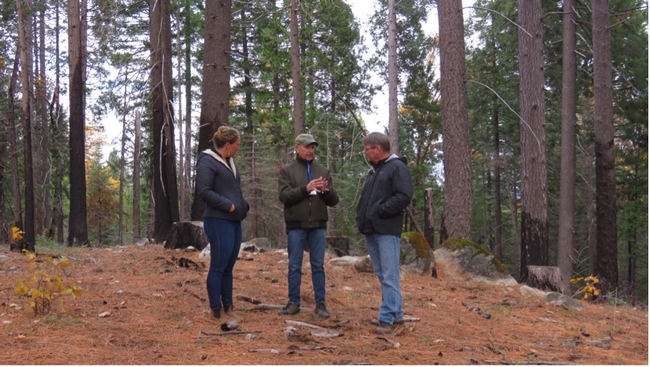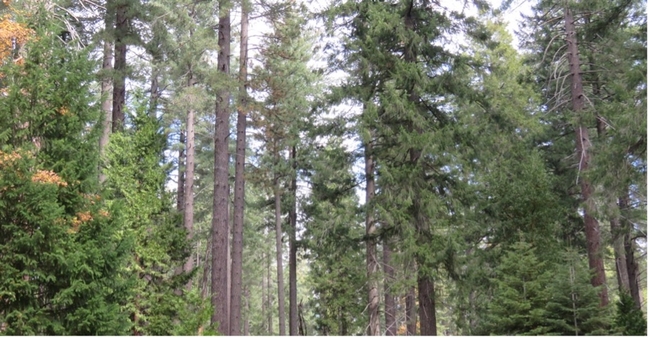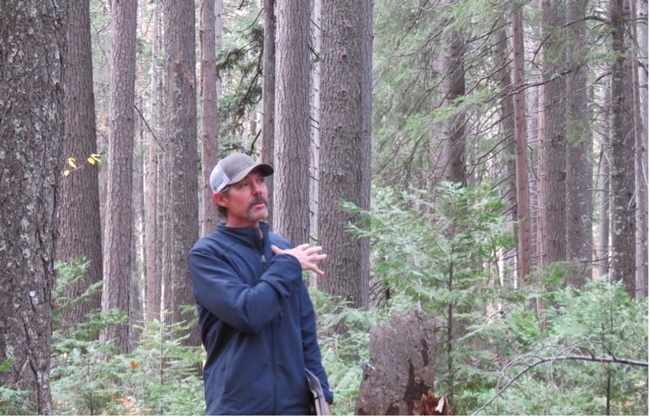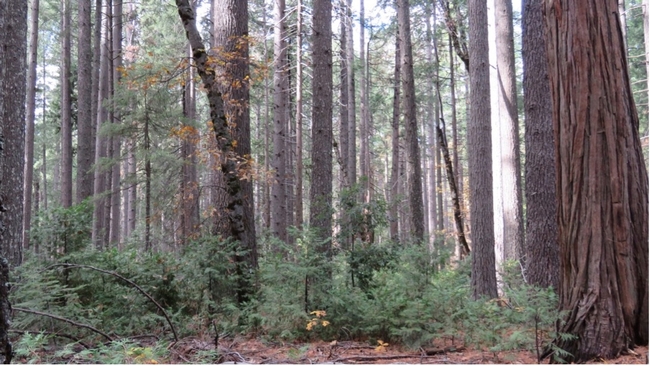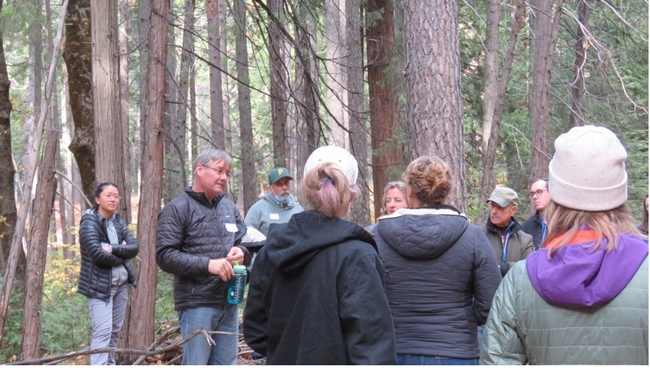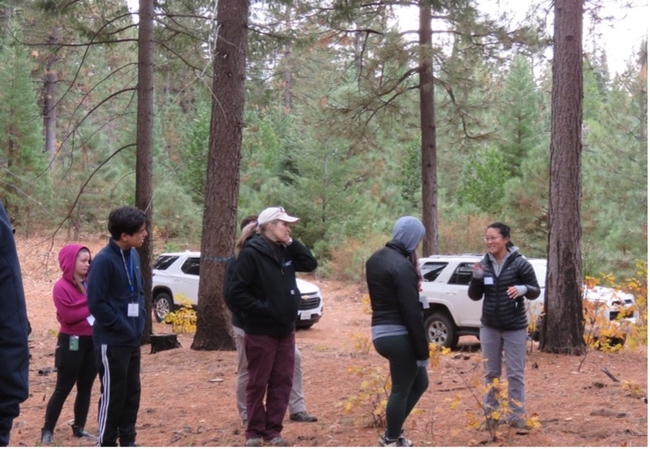UC ANR Fire Network hosts wildfire legislative tour with Berkeley Forests
As California grapples with more frequent catastrophic wildfires, the newly established UC ANR Fire Network plays an integral role in providing and advancing science-based solutions and delivering useful tools throughout the state. Recently, the Fire Network hosted an immersive field tour for California legislative staff in collaboration with Berkeley Forests to demonstrate their work in ongoing fire and forestry research.
“We have such a rich network of fire experts and thought leaders within UC ANR,” said Lenya Quinn-Davidson, Fire Network director. “It was great to have everyone in one place, thinking about how we can best inspire and empower positive change through our research, education, outreach, policy and training.”
During the Nov. 17 tour at Blodgett Forest Research Station, UC ANR staff and academics shared their research and experiences with a diverse group of legislative staff. The tour provided an opportunity for scientists and policymakers to connect over shared goals of addressing California's growing wildfire and forest management challenges.
Legislative staff members included Rita Durgin, legislative aide for Assemblymember Cecilia Aguiar-Curry; Spencer Street, legislative director for Assemblymember Vince Fong; Byron Briones, legislative aide for Assemblymember Freddie Rodriguez; Emily Watson, legislative aide for Assemblymember Joe Patterson; Les Spahnn, legislative director for Senator Bill Dodd; Tammy Trinh, policy consultant for Senator John Laird; and Catherine Baxter, consultant for the Senate Natural Resources and Water Committee.
Sitting on 4,000 acres of Sierra forestland, Blodgett Forest Research Station is the flagship site for research within the Berkeley Forests network. The in-person visit gave attendees the opportunity to learn about the different forest management approaches practiced at Blodgett and understand the importance of maintaining research forests across the state.
“We need research facilities like Blodgett,” Yana Valachovic, UC Cooperative Extension forestry advisor, told the group. “It's a way to ask these questions [about forest management].” The research questions answered through experiments at Blodgett have implications that reach beyond the station's boundary, which was demonstrated to tour guests over three tour stops.
UC Cooperative Extension forestry specialist and Berkeley Forests co-director Rob York led the four-hour tour, where visitors could view different forest management treatments and heavy equipment used for treatment, and learn firsthand about UC-led collaborative research projects.
‘Can you run through it? Can you see through it?'
Tour guests joined York at the first stop, a stand (a group of trees of similar age and size) that has not seen treatment by humans for over 60 years. This first stop was a glimpse at what an unmanaged forest looks like through a forester's or wildfire scientist's eyes. Small trees, less than a few feet tall, clustered under a dense overstory, can facilitate a wildfire's quick movement from forest floor to tree canopy. Close clusters of trees make it much easier for fires to burn across a stand, and the spongy layer of duff underneath the guests' feet burns hot when conditions are dry. These stand conditions, coupled with an abundance of downed woody material, can lead to intense fire behavior when conditions are hot and dry.
Leading California wildfire scientist and UC Berkeley professor Scott Stephens said, “Taking stands that look like this into the future with climate change…is nothing less than a trainwreck.” He and York emphasized that a forest's odds of persisting through wildfires are greatly increased when fuel loads are reduced and forests are thinned. York introduced his measure for healthy forest density, suggesting that guests ask themselves: “Can I run through it? Can I see through it?” the next time they visit a forest.
This is not to say that all fire is bad for a forest. Fire is a part of a healthy forest ecosystem and has been for thousands of years, thanks to natural ignitions from lightning and Indigenous stewardship and cultural practices.
The second stop on the tour was a stand where the overstory (canopy) had been thinned, but the surface fuels were not treated with prescribed fire. York explained that solely thinning a forest was not the answer, and that the best treatment would merge prescribed fire and overstory thinning treatments. In fact, a primary facet of the Fire Network's goals has been to increase the number and strength of community-based Prescribed Burn Associations (PBAs). Since 2017, 24 PBAs have formed throughout California and they greatly increase community capacity for prescribed fire in both forested and non-forested ecosystems.
Eating broccoli before dessert?
The tour ended at a stand that had seen both thinning and prescribed fire treatments. It is part of an experiment comparing prescribed fire emissions to wildfire emissions. Another fuels management experiment happening at Blodgett studies livestock grazing as a tool to manage live fuel loads. This project is a collaborative effort between UCCE livestock advisor Dan Macon, Fire Network coordinator Katie Low, and other ANR advisors and specialists. The effort exemplifies the way wildfire demands attention and innovation from outside the fire and forestry fields.
Macon and Low are examining the efficacy of goat grazing and its implications for animal health at Blodgett. This entails seeing how they can encourage goats to graze unfamiliar vegetation. Likening it to human behavior, Low asked the group, “If it was late at night, and you're craving a snack, which would you eat first: a bowl of steamed broccoli? Or your favorite dessert?” The goats that Macon and Low monitor clearly fill up on their “dessert” first and need extra encouragement to graze the woody vegetation, requiring more intervention on the herder's part. Through these glimpses into their research, Macon, Low and York demonstrated to the group that researchers are taking many approaches to help increase the state's wildfire resilience.
Sitting at a critical point of both research and application, UC ANR staff were able to give visitors their unique perspective on the topics of climate change, prescribed burning and forest management on this tour.
York, Stephens and Fire Network members maintained that California policy is moving in the right direction, but encouraged legislative staff to cease measuring impact through one lens. “It's not just about how many acres have been treated,” Stephens emphasized. “It's about impact. It's about changing the direction of the forest.”

